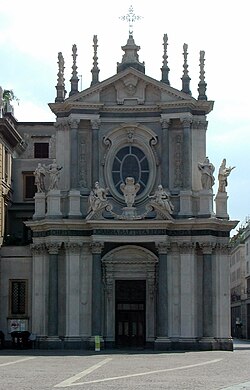| Church of Santa Cristina | |
|---|---|
Chiesa di Santa Cristina | |
 Façade of the church | |
Map of Turin | |
| 45°04′01″N7°40′56″E / 45.0669°N 7.6822°E | |
| Country | Italy |
| Denomination | Roman Catholic Church |
| History | |
| Dedication | Christina of Bolsena |
| Architecture | |
| Architect(s) | Carlo di Castellamonte, Amedeo di Castellamonte, Filippo Juvarra (façade) |
| Style | Baroque |
| Groundbreaking | 1640 |
| Administration | |
| Archdiocese | Turin |
Santa Cristina is a Baroque style, Roman Catholic church located in Turin, region of Piedmont, Italy. It mirrors the adjacent church of San Carlo and faces the Piazza San Carlo. The arrangement recalls the twin churches (chiese gemelle) of Santa Maria dei Miracoli (1681) and Santa Maria in Montesanto (1679) facing the Piazza del Popolo in Rome.
